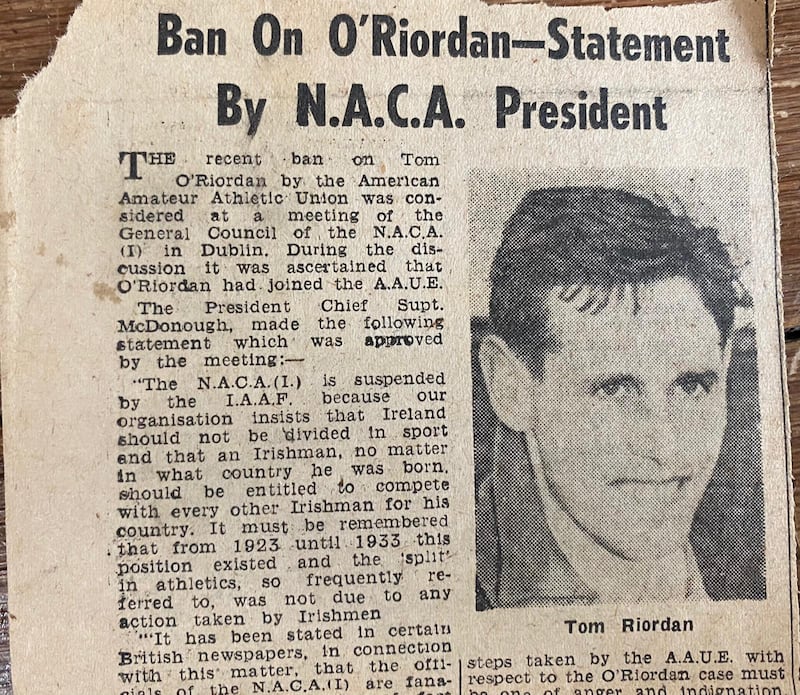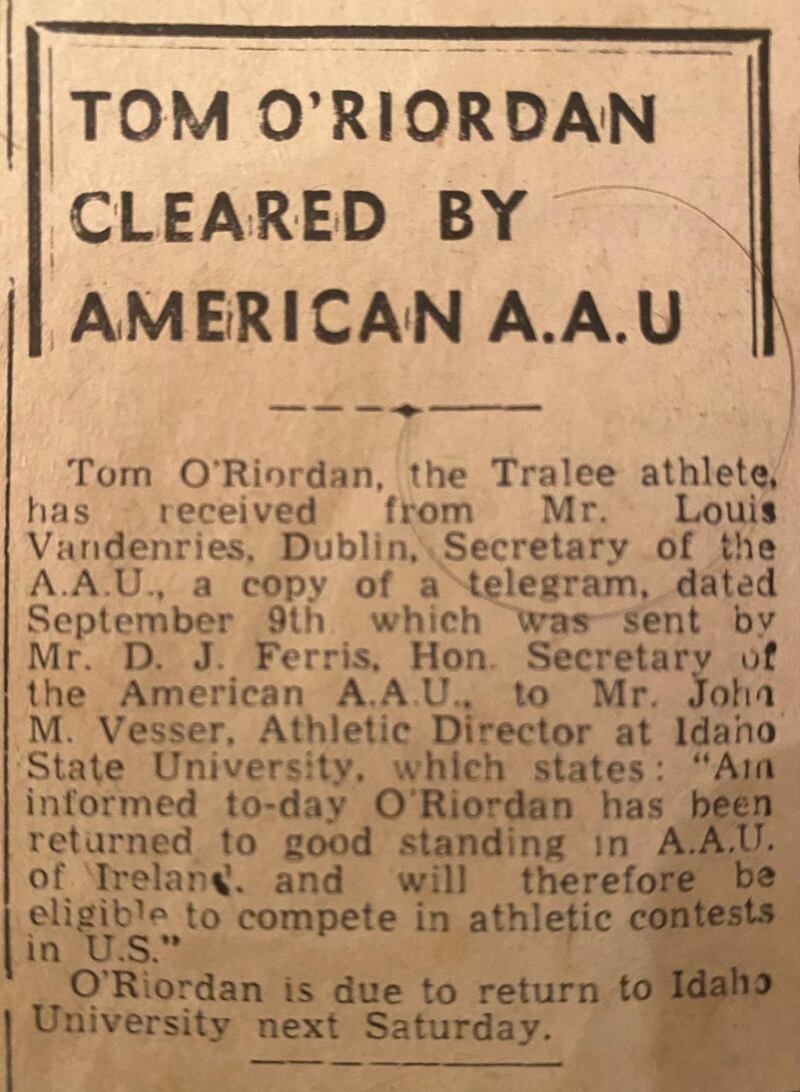We still don’t know who it was that ratted him out. Truth is it’s hardly even spoken about in the family anymore, as if another dark, dirty secret of Ireland’s athletics civil war more politely remembered as “the split”.
It’s hardly even relevant anymore, except that it’s traced directly back to the Anglo-Irish Treaty approved by Dáil Éireann a century ago, and a reminder of a time when trying to represent your country or indeed club of birth could end up being treated like some kind of criminal offence, a very different sort of Ireland’s call.
In the summer of 1959, three years after Ronnie Delany ensured Irish athletics made properly global headlines, interest in the sport was soaring, but in this country was still deeply divided. On one side, the National Athletic and Cycling Association (NACA), established in 1922 as the governing body with a view to representing Ireland, rather than just the newly formed Irish Free State; on the other side, the Amateur Athletic Union (AAU) of Éire, established in 1937 and representing the 26 counties only, once it become clear the NACA would no longer be recognised by the International Amateur Athletic Federation (IAAF).
This so-called split and war spilled into cycling too, and soon the victims caught in the crossfire started to mount. Not all sporting careers made it out of there alive; some fortunately did, and there are plenty of old newspaper clippings lying around this house to remind us. Writing in the Irish Press on August 18th, 1959, Sean Diffley took up the story of how close the war came to killing the career of one young Irish distance runner.
“Tom O’Riordan, the 22-year-old Tralee athlete who, as a result of his competing at NACA meetings while at home on holidays from Idaho State College, USA, has been banned by the International Amateur Athletic Federation is still undecided about his next move.”

Scholarship
He was home at his aunt’s house in Castlecountess in Tralee that summer, for the first time in two years, after taking up a running scholarship in 1957; transatlantic airfares were tremendously expensive back then. The AAU may have been the governing body recognised by the IAAF (the NACA definitively expelled in 1935, after voting against the ruling member associations be delimited by international political boundaries), but the NACA still represented the vast majority of Irish clubs, especially outside of Dublin, including his own Kerins O’Rahilly’s.
Diffley continued: “Tom, who seems sorely puzzled about the whole matter, told me that he was in touch with Mr Billy Morton yesterday, seeking information about becoming a member of the AAU. ‘I have always been a member of the Kerins O’Rahilly’s club in Tralee and had no idea that I would be jeopardising my scholarship to Idaho State College by running with the club during my holidays.’”
O’Rahilly’s club secretary Richard Eager, being “extremely annoyed” by the action of the AAU in bringing about the ban by their letter to the American AAU, then added. “I can’t understand how a small group that represents nobody outside of Dublin can hold the power to ruin a young boy’s career.”
Essentially the only solution was to become a member of the AAU, or at least get back into their good standing. Any athlete representing the NACA could be banned from international competition, once they were reported, which is exactly what happened here, someone in the AAU notifying both the IAAF and the American AAU. With no hearing, no appeal, his running career was suddenly over, at home and abroad.
Enter Louis Vandendries, the honorary secretary of the AAU, who Diffley reported was “on holidays” during the period the council of the AAU informed the IAAF and the American AAU of O’Riordan’s participation at NACA meetings.
“My own personal opinion is that the AAU would have been wiser to ask Mr O’Riordan to get in touch with me,” Vandendries said. “On the other hand, I do not approve of O’Riordan’s action in competing at NACA meetings whilst being a member of the IAAF. I certified him as being an amateur and only for that certificate being issued he could not have competed in the USA.”

Banned
Around this same time, Kerry’s leading cyclist Gene Mangan, who in 1958 won the last four stages of the Rás Tailteann, was also banned from international competition because of his links with the National Cycling Association (NCA), which was carved out of the NACA, and not the Cumann Rothaíochta na hÉireann (CRÉ), cycling’s equivalent to the AAU.
Later, in a statement to the Irish Independent, NACA president Thomas McDonagh, a chief superintendent in Dublin, appealed for some common sense from the AAU, the ban it seemed based solely on fear, envy and meanness.
“The NACA is suspended by the IAAF because our organisation insists that Ireland should not be divided in sport and that an Irishman, no matter in what country he was born, should be entitled to compete with every other Irishman for his country. It should be remembered that from 1923 to 1933 this position existed and the ‘split’ in athletics, so frequently referred to, was not due to any action taken by Irishmen.
“In this matter no blame can be attached to the American Athletic Union, except that their action appears to be precipitate and that O’Riordan has been convicted in absentia.”
He added: “One’s first reaction to the steps taken by the AAUE with respect to the O’Riordan case must be one of anger and indignation, but with me, in any case, and with most members of this association with whom I discussed this matter, it promotes a feeling of deep sorrow that any Irishman or body of Irishmen should resort to such measures to injure not alone the athletic career, but the prospects of life of another Irishman . . . if he was just a mediocre competitor I have no doubt but the people who reported him to the IAAF would have taken no notice of him. Previous similar instances can be quoted to prove this.”
A month later the ban was lifted, in the main due to the intervention of Vandendries, a telegram, dated September 9th, 1959, sent by Dan Ferris, long-serving secretary of the American AAU, to Idaho State College, saying: “Am informed today O’Riordan has been returned to good standing in AAU of Ireland, and will therefore be eligible to compete in athletic contests in the US.”
Three months later, competing at a different NACA event, the National Collegiate Athletic Association cross-country championships in East Lansing, Michigan, the 22-year-old Tralee athlete finished fifth, the then best-ever placed Irishman, one place ahead of Billy Mills from Kansas.
Running well is the best revenge.













